Lion Facts
Quick links to Lion Facts categories.
|
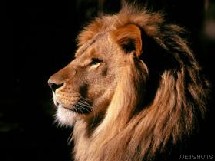
|
|
|

Physical Characteristics
|
Length:
|
7-10 feet long
|
|
Height:
|
120 cm (48 in)
|
|
Weight:
|
300-550 lb
|
|
Teeth:
|
30 teeth (including 4 large teeth called "canines")
|
|
Colour:
|
Golden/tan with white underparts often faintly spotted (especially in East Africa); black tail tuft, back of ears and lips; mane differs from each lion, from blonde to black.
|
Other facts
- A lion has retractable claws like many cats.
- Coat short except for tail tuft and a mane, that appears at three years old and maximum size at five years.
- A lion is the only feline with a tuft on the end of their tale.
- Lions have excellent eyesight, very good hearing and a good sense of smell to catch their prey with and to protect their territory.
- A lion will sleep or rest up to twenty hours a day and hunt for four hours.
- Lions do not like to swim and will only enter water for good reason, e.g. food.
Mane: There is no sure answer as to the question why lions have manes. Some people believe the mane acts as protection against other lions bighting the neck in fights, but lions often fight by biting on the back. One other possibility is that the mane is there to attract the female lions. Charles Darwin was the first to suggest that the mane may be a result of "sexual selection" meaning that the mane may play a role in reproductive selection.
Geographical Range and Habitat
Prides of lions are highly territorial and often occupy the same area for many years. Territory size depends on features such as prey availibility, permanent water sources and suitable places for hiding young cubs. Males will defend their territory and prides from rival males.
The size of a prides territory can be huge but the defended territory of the moment is the size that a lion scents it. A male lion will spray a special scent on bushes, high grass etc on the boundaries of their territory to warn off nomad male lion/lions and also to warn off other prides. Female lions do spray but only occasionally. A male lion will also put paw marks in the soil to ward off unwanted guests in the territory. A female and male lion will begin marking and scenting at about the age of two.
Social System
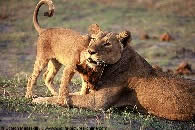
Lions in prides share a strong social bond reinforced by behaviors such as head-rubbing and social grooming. While females direct most of their attention to other females and cubs, male lions are most attentive to each other. Males do this because males only spend two years with a pride, but remain bonded with their male companions throughout their lives.
Males and females will touch one another when lying down to show affection to one another and greeting. The lions rub so hard on one another that one of the lions usually end up falling on top of the other lion. Males will strut in front of females to show their dominance.
Diet
The lion is a carnivore, and feed mainly on large herd animals so the whole pride will be able to feed. A lions diet mainly consists of:
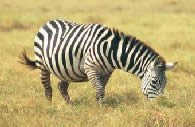
- Zebra
- Buffalo
- Wildebeest
- Wild Hogs
- Antelope
- impala
- giraffe (if the adult giraffe has fallen or a baby giraffe)
A lion will sometimes eat till their bellies look like it will explode, the amount of food is about 66 pounds (30 kg), they do this because the lion may not catch any prey to eat for up to five days. This is why the lion will sleep or just laze around for around twenty hours a day and only move around or hunt for about four hours.
Lions do not really like to share their food and often fight for places at a kill with prime males taking the proverbial "lion's share", up to 25% of their weight.
The lion is also a scavenger and will eat the dead carcass of an animal. They can sometimes tell where a dead carcass is by the circling of vultures or vultures milling around on the ground. The lion has a sense of when an animal is dying or sick also and will attack the dying animal. A lion will also steal food from the hyena, one group of people say the lion is the better hunter and another group say the hyena is the better hunter. All in all, the lion and hyena are both exceptional hunters and both steal food from each other.
Foraging / Predatory Behaviour
Although the females do most of the hunting, when the male lion hunts, he usually only hunts for himself when no free lunch is provided by the lionesses or other means. The male is not a great hunter, mainly because of his bulk and the largeness of his mane.
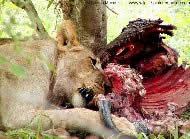
Hunting is usually done by the female in the early evening and early morning although if prey is abundant during the day the female/male lion will hunt. The female lion captures most of the prey although the male, with its giant size will catch the more larger prey (buffalo etc). Even though the female is usually the hunter, the male lion will usually eat first, usually with the cubs and the females come to the dead animal later.
Male/female lions will travel for kilometers to find food.
With the lions sleek and flexible body, it is able to hide among the long grass of the wild while the lion stalks his prey. The lions golden/brown colouring is also helpful by blending in with the tall grass and surroundings, with these two traits the lion is able to sneak up very close to its prey before sprinting after the animal.
It is plausible that lions are the only sociable cats because a single lion has only 17% to 19% of catching prey, while a group of lions has around 30% chance. This is possible so that lions could share food with relatives and also protect their food from competitors, including other lions, as the old saying go's 'strength in numbers'.
When a lion is threatening another animal, including prey, danger or another lion , the lion will:
- Keep its head low
- Forelegs wide apart
- Shoulders higher than normal
- Gazes at opponent with their eyes and mouth (if the lion is snarling during this, it means the lion is more on the defense)
- Ears twisted so that their black marks face forward
When a lion lashes its tail up and down during any threatening display and the lion growls or coughs, this shows a charge is imminent.
Male Coalitions
Male coalitions are usually related males that has left their pride as adolescents and stayed together as nomads until they are mature and ready to compete.A lone nomad may join other lone nomads to form a coalition as formable as sibling coalitions.
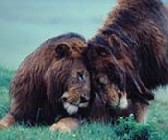
Once a coalition has taken over a pride, after an enduring battle with the prides origional lion/coalition, the victors usually have only two years before losing in turn to a younger and stronger or larger coalition. The larger the coalition of lions the better, as a coalition of 4 to 6 lions may last up to four years.
Coalitions of four or more lions in a pride are very rare.
Reproduction / Life Span
Male lions start breeding at around the age of five.
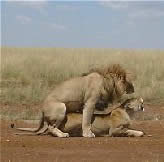
Once a male lion or a coalition of male lions have taken over a pride the new male lions will kill all the suckling cubs of their rivals to start the lioness coming into heat. The lioness will come into heat every couple of weeks for 4 to 5 months without becoming pregenant, this occurs to try and stop desertion of the females and to help the new lion/lions to bond with their new pride., so that the new male lion/lions of the pride can start propagating their genes with the lionesses. When the sterility period ends, pride females ovulate, conceive, and litter in synchrony. The cubs are then reared communally, improving the chances that a sizable male coalition will eventually propagate their parents genes.
Male lions that are within the same pride do not compete with each other over mating rights with females. The first male to encounter a female on heat has dominance over her, until the mating is finished or until the male is tired of mating.
The prime years for a male lion are 5 to 9, at 8 years old they are already losing weight and mane hair and few survive past 10 years old.
Fatherhood
While mothers bear the brunt of caring for the cubs, fathers also make important contributions. The males protect the females and cubs from strange lions and also catch large prey from which the whole pride can feed.
When cubs are small, males generally remain at a distance from the pride but older cubs are fascinated by their fathers, often approaching them and trying to play. This often results in either the lion telling the cub to go away or if the cub is lucky and the lion is in a good mood, the male will play while teaching the cub fighting skills in the process.
A lion will most often have first bite at any new kill that is available (either killed by the lionesses or natural causes) and the lionesses will wait for their turn. The cubs are the only ones allowed to feast with their fathers.
Top
of Page
|
Back to
Index Page
|
Lion in Astronomy and Astrology
Astronomy
The Lion (also Great Lion, Leo major) is one of the constellations of the Zodiac. It comprises 77 stars that are visible to the 'unarmed' human eye. The brightest is Regulus (='Little King') at 85 light-years from Earth, the second brightest Denebola at 42 light-years. Eta Leonis, north from Regulus, looks weak, but it spreads a hundred times as much light as Regulus. This star is at a much greater distance from Earth: 1700 light-years.
The constellation of Lion was already mentioned in the famous Almagest of the Egyptian astronomer Ptolemaios. Copernicus gave Regulus its name during the Fifteenth Century.
A second lion-constellation is Little Lion (Leo minor), introduced around 1670 by the German astronomer Hevelius. Leo Minor can be found between Great Lion and Great Bear. This constellation consists of 24 visible stars, but no particular bright ones.
Astrology
Leo is the fifth constellation of the Zodiac. Between July 21 and August 21 the Sun is in the constellation of Lion. What astrologers say about the astrological Lion:
Lions are often leaders and they expect unconditional obedience from other people, which they mostly get because of their innate talent for leadership. Often a Lion is in the center of power and he doesn't tolerate that others resist his position. The Lion is an honest and righteous leader, who rises against injustice. He also wants justice from other people and when they disappoint him, then he will mourn that deeply.
Lionesses are strong personalities too. They do not like to live under other people's authority. They respect authorities, but they do not lose their self respect and they won't make themselves subordinate. Lionesses are very skillfull in delegating tasks.
Sounds Lions Make
Lions only make a sound when they are exhaling, unlike the house cat that continually make a sound.
-
Roaring:
-
Roaring can be used for many reasons and can be from a soft huh to full throated roarsheard kilometers away. Lions usually roar standing or crouching but roaring is possible from any position. Male lions roar deeper and louder than females but the sex and distance of a lion is hard to judge. Some of the reasons for roaring can be:
- Advertise territorial occupancy
- Contact pride members
- Strengthen social bonds (roaring in chorus)
- Intimidate rivals during aggressive interactions
-
Humming:
-
Humming is the sound of contentment, like purring, that is emitted during affectionate interactions and while cubs nurse.
-
Puffing
-
Puffing is a sound made when lions approach each other with peaceable intentions, makes a faint pfft pfft sound.
-
Woofing
-
Woofing is a sound made when a lion is startled.
Copyright 2004

| 

